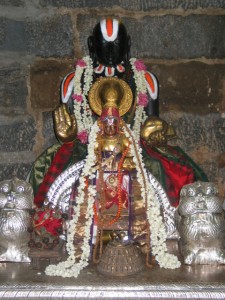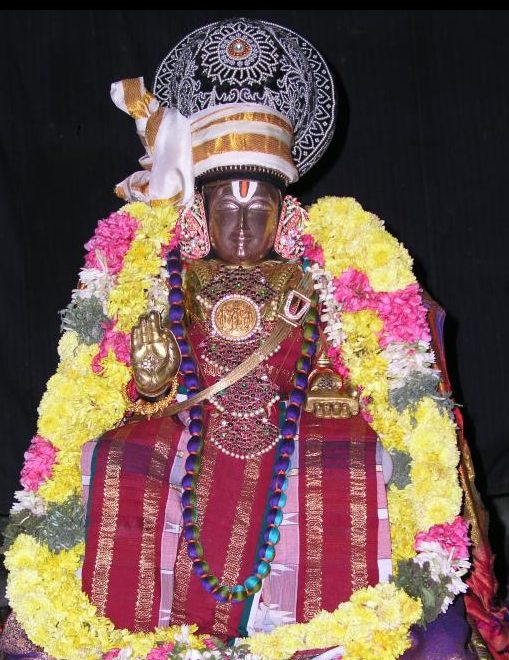 The Bhagavata Purana says that in the Kali Yuga, holy persons devoted only to Narayana, will be born more in Dramida desa, on the banks of the rivers Tamraparani, Vaigai, Palar, Kaveri and Periyaru in the west (kerala). Svami Desika says in his Magnum opus the Rahasyatrasara that this prophesies the advent of the Azhvar-s. With equal emphasis, we can also say that this prophecy refers to the advent of Desika also.
The Bhagavata Purana says that in the Kali Yuga, holy persons devoted only to Narayana, will be born more in Dramida desa, on the banks of the rivers Tamraparani, Vaigai, Palar, Kaveri and Periyaru in the west (kerala). Svami Desika says in his Magnum opus the Rahasyatrasara that this prophesies the advent of the Azhvar-s. With equal emphasis, we can also say that this prophecy refers to the advent of Desika also.
Svami Desikds avatara (birth) is a wonder; his life history is a wonder; and his prodigious works are a greater wonder; as we shall presently see.
Sri Ramanuja (1017 – 1137 AD.) entrusted to 74 apostles the task of continuing his mission of spreading the Sri Vaishnava religion and Visishtadvaita among the misses. One such apostle was Anantasomayaji, whose son was Pundarikaksha, who had also performed soma yaga like his father. Pundarikaksha’s son was Anantasuri, who even as a young lad, had mastered all sastra-s. Another famous apostle and affectionate disciple of Sri Ramanuja was Kidambi Achan, whose descendant was Athreya Ramanuja(Appullar) a specialist in Nyaya sastra. Appullar offered his sister Totaramba in marriage to Anantasuri, the scholarly son of Pundarikasha.
No bell is used in the temple at Tirumala, even today
The married couple, Anantasuri and Totaramba lived happily in Thooppul, a suburb of Kanchipurm. Thooppul meam holy grass i.e. Dharbha and the place was so named, apparently because darbha was growing there in abundance. The couple went on a pilgrimage to Tirumala where they both dreamed that Lord Venkatesa gave the holy temple bell to Toaramba, who swallowed the same.
Twelve years later, Svami Desika was born on Purattasi Sravanam day (I268 A.D.), which was the Tirthavari day during the Brahmotsava of Lord Venkatesa and is therefore regarded as the the Tirthmari day incarnation of the holy bell at Tirumala. In commemoration of this, no bell is used in the temple at Tirumala, even today.
There are quite a few autobiographical sketches in Desika’s works which corroborate this point. His allegorical drama sankalpa suryodaya states: ‘The bell used by Brahma for the worship of the Lord Srinivasa, and which drives away ghosts and demons, is regarded by wise men as having been incarnated as the author(Desika)’.
Apart from this Desika’s son Nayinaracharya and his sishya, Prativadi Bhayankaram Annan also mention this aspect in their works, besides many other biographers.
Here we may point out an interesting and strange conicidence. Or, was it willed by the Lord that way? The sastras say that Narayana Himself takes human form and out of mercy, lifts up people immersed in the ocean of samsara, wirh His hand, which holds a sastra. Now the Vedas declare that Sravana is the star of Vishnu and of our Azhvars and Acharyas, the firsr Azwar, Poygai and the last Acharya, Vedanta Desika, were both born in the same star Sravanam, indicating that they are indeed avataras of Vishnu. Again, there is another significant coincidence. The first Azhvar Poygai was born in Aippasi Sravanam and the last Acharya, Desika was born in Purattasi Sravanam, completing the cycle of the year (starting from Aippasi, Dipavali month, lighting the lamp of knowledge and ending with Purattasi). Are these just coincidences or God’s will ? Only He knows.
When Desk was five years old, his uncle Appullat tookhim along to a spiritual dkourse (iT&kl.l.p.mj conducted by Vatsya Varadacharya (Nadadur and affectionately called as – mother – by Lord Varadaraja, because he was daily offering to the Lord, milk at the right temperature, neither too hot nor too cold – Iike a doting mother) Other scholars like Sudarsana Bhatta and Vadakku Tiruveethi Pilai were also attending the discourse. When the child Desika arrived on the scene, his efflugence amazed the scholars including the lecturer who forgot the portions which they were studying then. And it was the precociuous child Desika who reminded them about the exact point forgotten. A joyful Nadadur Ammal blessed Desika: “May you live long, establishing Vedanta on a firm footing; vanquishing rival religions and philosophies; duly respected by Vedic scholars, and be the recipient of abundant glory!.” This incident again is recounted bv our Svami in his Adhikarana Saravali.
Appullar was the master under whom Desika studied the Vedanta and all sastras in detail and soon mastered them all. The Svami says in all humility that Appullar taught him all sastras, with so much patience and loving care, as a man would teach a parrot to speak. He completed study of all sastras, arts and sciences, by the age of twenty. This fact is mentioned by the Svami in the Sankalpha Suryodaya. As Sri Desika says, “We alone have sweet and lovable intellect in writing kavyas and not others, we alone have sharp unrivalled intellect in sastras and not others; we alone have unshakable intellect in regard to religiou works and not others; we alone have our mind fully dedicated to and concentrated upon Krishna and not others”.
In course of time, at the appropriate age, as per the wishes of elders Venkatanatha entered into marrimony. He remained a householder throughout. Apparently he did not consider it necessary to adopt samnyasa The great Tamil poet Truvalluvar echoes the same sentiment in his Tirukkural ‘If one leads the life of a householder in accordance with dharma what does he gain by adopting samnyasa? (Nothing)’.
Appullar then initiated Desikan into Garuda mantra. The Svami proceeded to Tiruvahindrapuram and seated on the hillock there, meditated on Garuda, repeatedly chanting the manthra. Pleased by his devotion, Garuda appeared, blessed him and instructed him in the Hayagriva mantra. In due course Lord Hayagriva also appeared before him and blessed him. Composing stotras and prabandhas in praise of the various deities there, Daika lived happily for quite some years. Returning to Kanchi, he composed several storras and prabandas on Varadaraja, with loving devotion.
Our Svami’s next sojourn was Tirupati, where he composed in praise of the Lord‘s grace, the famous Daya sataka (108 slokas), as an epitome of the 1000 verses of the Tiruvaymozhi of Nammazhvar. Rounding up wth a tour of North Indian divya desas and other holy spots, Desika settled down in Kanchi again.

Sri Desika chose to live a life of extreme simplicity and was content with accepting whatever was offered voluntarily, which is known as unchavritti. Even today unchavritti is reverentially called Desika Vritti. His friend Vidyaranya, moved by the extremely austere life led by Desika, invited him to the royal court of Vijayanagar, assuring him of regal reception and patronage.
Was the Svami one to succumb to such temptations ? No. He spurned the offer and in reply wrote five moving verses, popularly known as Vairagya Panchakam. In these slokas, Desika observes:
‘We do not wish ro earn our livelihood by flattering petty kings who rule over only a small part in one corner of the world, but are puffed up with arrogance. We will only serve the supreme Lord who gave Kuchela , the status of the lord of riches, and none else.
Are not a few grains collected from the paddy fields sufficient to alleviate one’s hunger? Is not a handful of water from a tank sufficient to quench one’s thirst ? Will not some rags found on the roadside serve as our clothng ? Why should even learned people praise arrogant kings for their sustenance ?’
Even today unchavritti is reverentially called Desika Vritti.
No riches have been left behind by my father. Nor have I earned anything. But I have the supreme wealth Varadaraja, on the top of the hilld at Kanchi, left behind by Pithamaha Brahma (Grandfather).
To be continued…
Source: SrI Nrisimha Priya October 2003










Is this still relevant for today? Or have things changed? What I’m curious about is how this will carry out, like what will the trend be for this type of stuff?